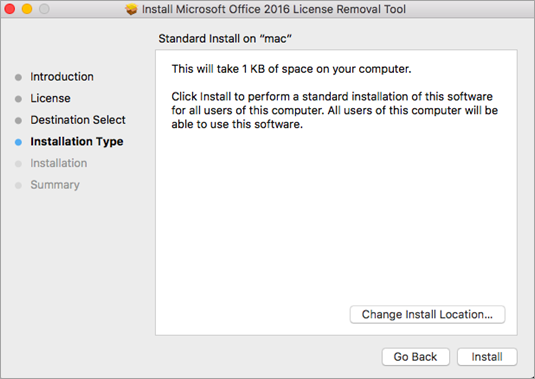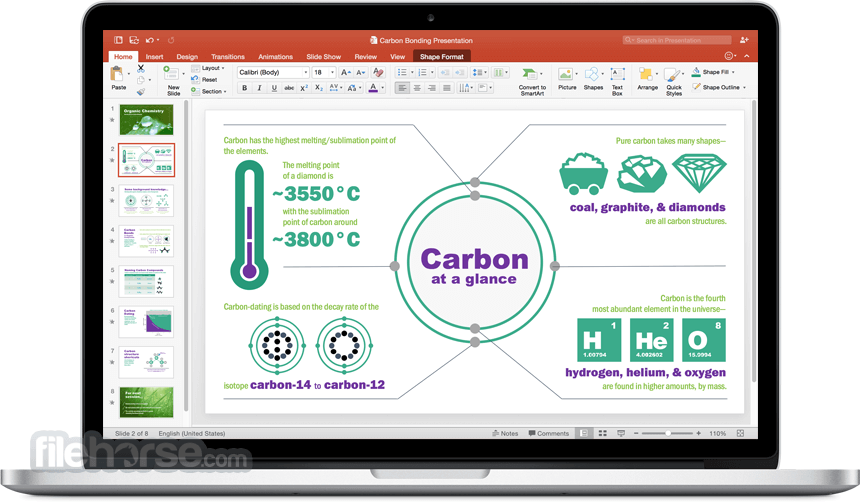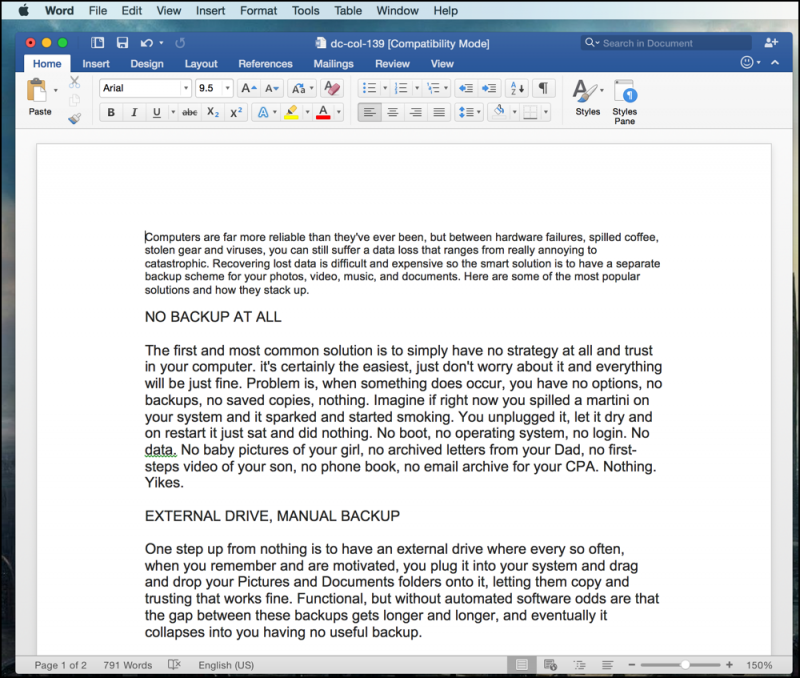Office 2016 Mac Back Up
- Open up the Word application on your Mac and then click the menu Word Preferences Save and then check the option “Always create backup copy” For PC users. Open Microsoft Word and go to Option by clicking on File tab Options. ( Older version users need to click Office icon left-top corner and then click button “Word Options” from menu.
- Steps to back up Microsoft Office data with AOMEI Backupper 1. Install and run the freeware. Select “File Backup” under “Backup” tab.
- Installing Office 2016 is easy. We'll walk you through the steps. For more help, visit https://support.office.com/.
- Select the disk location (it can be an internal HDD/SSD or a removable storage device) where you.
The complete, easy guide to backing up your Mac You know about Time Machine, but there are other ways to back up your Mac. Here's how to pick the best backup method for you.
How do I make a backup of all my contacts in the Address Book in Outlook?
The short and easy answer to this question is;
- POP3 accounts
If you keep all your contacts in the Contacts folder of Outlook, simply make a backup of your main pst-file. The pst-file is the database that Outlook uses to store your mail, contacts, calendar items, tasks, notes and journal items in. - IMAP accounts
- Outlook 2007 and Outlook 2010
Just like a POP3 account, your contacts are stored in your main pst-file (so not the one of your IMAP account). Making a backup of that pst-file also includes your Contacts. - Outlook 2013 / 2016 / 2019 / Office 365
When you only have an IMAP account configured in Outlook, then your Contacts are stored in a “This computer Only” folder. In that case you can export or copy the Contacts folder to a pst-file as described in the “Backup Contacts folder only”.
You can also force Outlook to store your Contacts directly in a pst-file so you can backup this file. For details see; Don’t risk losing your Contacts and Calendar when using IMAP in Outlook 2013 or Outlook 2016.
- Outlook 2007 and Outlook 2010
- Exchange accounts
If you are using an Exchange account, then your contacts are stored on the Exchange server which should be backed up by your email administrator. Contact him/her if you want to know the frequency of the backups. You can also use the “Backup Contacts folder only” process explained below to make a backup of your own. - Outlook.com and Hotmail accounts
While Microsoft does make backups of its Outlook.com (Hotmail) servers, it is recommended to still make your own backups as well. Use the “Backup Contacts folder only” process explained below to make a backup of your own.
Note:
Outlook 2007 also keeps a cache of used addresses in an nk2-file. To backup or restore these addresses see; Import contacts from an nk2-file.
Outlook 2010, 2013, 2016, 2019 and Office 365 also have an AutoComplete list of addresses; Backing up and restoring the AutoComplete cache of Outlook 2010, 2013, 2016, 2019 and Office 365.
Backup Contacts folder only
If you keep all your contacts in the Contacts folder and you only want to backup your contacts, then you can create a separate “Backup Contacts” pst-file for this;
- Add a new pst-file to Outlook and name it “Backup Contacts”
- Outlook 2007
File-> New-> Outlook Data File… - Outlook 2010 / 2013 / 2016 / 2019 / Office 365
tab Home-> button New Items-> More Items-> Outlook Data File - Office 365 (Simplified Ribbon)
tab Home-> drop down button on the New Email button-> More Items-> Outlook Data File…
- Outlook 2007
- Select the Contacts Navigation (keyboard shortcut CTRL+3).
- Right click the Contacts folder of which you want to make a backup and choose Copy Folder.
- In the dialog that pops-up, select the “Backup Contacts” folder set and press OK.
- Repeat step 3 and 4 for each of the contacts folder which you would like to backup (like for instance the Suggested Contacts folder).
- Close Outlook and make a copy of the newly created “Backup Contacts” pst-file to your backup location.
To backup only your contacts, you can copy them to a separate pst-file.
Restoring your Contacts
When you need to recover one or more Contacts from your backup file, you can restore it to your local hard drive (make sure not to overwrite any existing pst-files) and connect to it in Outlook via;
- File-> Open-> Open Outlook Data File

You will now see your connected pst-file in the Navigation Pane. Expand it to find your restored Contacts folder and copy the contacts back to your Contacts folder.

When you are done, you can disconnect the pst-file via;
- Outlook 2007
File-> Data File Management… - Outlook 2010 / 2013 / 2016 / 2019 / Office 365
File-> Account Settings-> Account Settings…-> tab Data Files
The (more) technical answer…
The Outlook Address Book itself cannot be backed up as such since no addresses are stored in it;
- The Address Book in Outlook is nothing more but a container for address lists; is does not hold any addresses itself.
- An address list is a container that holds the actual addresses. Common address lists for Outlook are;
- Contacts folder
- Global Address List (when using Exchange)
- LDAP (when using another server-based directory list)
How to backup the the Contacts folder has been described at the beginning of this tip. If you have additional contact folders (such as the Suggested Contacts folder), they can be backed up in the same way.

A Global Address List (GAL) and LDAP lists are located on the mail or directory server that you are connecting to. There is no need for you to make a backup of these address lists as they fall within the management of the server itself. If you were to reinstall your computer, these address lists are not affected and will be made available again when you reconnect to the server.
Note: Your mail administrator can help you getting the needed settings if you did not write down your account configuration settings before reinstalling.
How to Backup Outlook 2016 for Mac Data
Backing up data can be necessary thing to do in some cases, but it’s also a good habit to regularly backup your data to a safe location. Outlook 2016 for Mac is a great email client, but just like everything else in the computer world, nothing is immune from data loss, corruption, or other unfortunate events.
Backing up data from email client to local files not only keep your data safe, but can also free up space from mail servers.

Another important reason to backup Outlook 2016 for Mac data to OLM files is email migration. If you ever want to switch your client from Outlook to other clients such as Apple Mail or Thunderbird, you might need OLM files (archived proprietary data file format used by Outlook) to move your database.

So, if you haven’t backed up your emails, contacts, calendar entries, and other items from Outlook 2016 Mac to a safe location, do it now. The tutorial below will take you through each step.
You can do it either manually or use Mac Timemachine feature to set up automatic backups on regular basis.
Manual Backup of Outlook 2016 for Mac Data
Outlook 2016 for Mac (and other previous editions) use .OLM as the data file to store contents. You have to use the same file for backup and safekeeping.
Here are the simple steps:
- 1. On the tools tab, choose ‘Export’
- 2. Choose the items you want to backup. For the purpose of this article, choose everything since you want to backup the entire OUtlook 2016 database.
- 3. Choose the location to save the OLM files and click ‘Save’
- 4. Once the data is exported to .OLM files, click ‘Finish.
Keep this OLM file somewhere safe for future purposes, such as, if your Mac Outlook gets corrupt and damages the native profile folders. You can also use this file to share emails and contacts with other Mac Outlook users. And also, through third-party email migration tools, you can convert this file to other formats for Apple Mail, Thunderbird, or other clients.
Use TimeMachine to Automatically Backup Outlook 2016 for Mac Data
TimeMachine is an Apple OS program that allows you to backup data, preferences, and other items. It’s best use is to set up a backup schedule to automatically make copies of the files on a regular basis. In the tutorial below, we’ll learn how to use it to set up a regular backup schedule for Outlook 2016 data.
- 1. On the Apple Menu, click ‘System Preferences’ –> Time Machine
- 2. Switch the TimeMachine “ON” and click “Select Backup Disk”
- 3. You can also click “Options” to choose what items you want to backup. If you want only to backup Outlook data, un-check all other programs and items other than Outlook.
- 4. Select the location to save the backup files and click “Use Disk”
NOTE* – TimeMachine requires an external hard drive (USB, FireWire, or Mac OS server), and it is usually a backup machine for your entire Mac (not limited to just Outlook). Also note that when you restore the backup files from TimeMachine, it may take a long time for Outlook to restore data completely.
Office 2016 Mac Os
As said earlier, you can use these files for various reasons. One of the most common ones is to keep them in a secure location for safekeeping. You can share them with other Mac users if you want to share the data such as emails and contacts.
Office 2016 Mac Back Up Windows 10
If you are moving to another client or want to share the OLM file with a user that doesn’t have Mac Outlook, you need to convert it to the appropriate format (like EML for Outlook Express, MBOX for Apple Mail, and so on). Use “OLM Extractor Pro” as a third-party tool to convert your backed up OLM file to all major Mac email clients’ format.